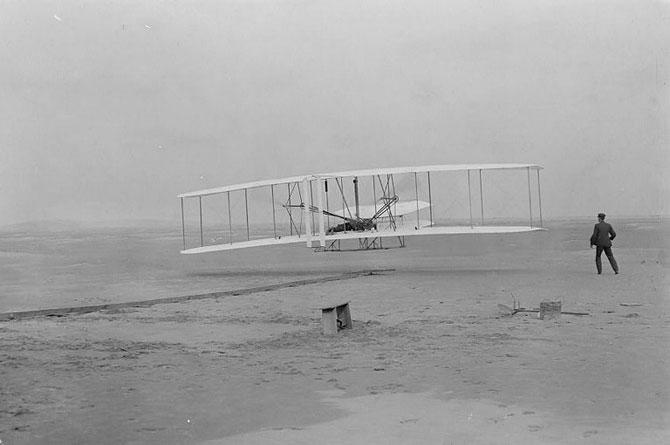Aviation history was made today on December 17 in 1903, when the Wright brothers, Orville and Wilbur Wright made their first controlled powered, heavier-than-air flight in the Wright Flyer at Kitty Hawk, North Carolina, USA

Wright Brothers, The Wright Flyer, aviation history, special feature, Kitty Hawk, North Carolina, Orville Wright, Wilbur Wright
Aviation history was made today on December 17 in 1903, when the Wright brothers, Orville and Wilbur Wright made their first controlled powered, heavier-than-air flight in the Wright Flyer at Kitty Hawk, North Carolina, USA.
The 1903 Wright Flyer also referred to as Flyer I or 1903 Flyer flew forward without losing speed and landed at a point as high as that from which it started. With Orville Wright as pilot, the airplane took off from a launching rail and flew for 12 seconds and a distance of 37 meters (120 feet).

The photograph of American aviators Wright brothers, Orville and Wilbur, make the first flight successfully in a heavier-than-air-machine, The Wright Flyer on December 17, 1903 at Kitty Hawk, in a flight of 70 metres. Pic/AFP
The original 1903 Wright Flyer is the centerpiece of "The Wright Brothers & The Invention of the Aerial Age" exhibition at the Smithsonian's National Air and Space Museum's flagship building in Washington, DC.
In March 1999, a full-scale replica of the 1903 Wright Flyer was mounted in NASA Ames Research Center's 40-foot by 80-foot wind tunnel for tests to build a historically accurate aerodynamic database of the Flyer. For two weeks, engineers studied the replica's stability, control and handling at speeds up to 27 knots (30 mph) in the wind tunnel. The Wright Flyer replica was constructed by a team of volunteers from the American Institute of Aeronautics and Astronautics using plans provided by the Smithsonian. The replica featured a 40-foot-4-inch wingspan reinforced with piano wire, cotton wing coverings, spruce propellers and a double rudder. Although it replicated the 1903 Wright Flyer in design, size, appearance and aerodynamics, some changes were made to make it stronger for mounting in the wind tunnel.
ADVERTISEMENT
A full-scale model of the Wright Flyer airplane at the Vivesvaraya Industrial and Technological Museum in Bangalore, 18 December 2003. The display made from fibre-glass to commemorate the centennial of the first powered flight by aviation pioneers Wilbur and Orville Wright at Kitty Hawk, North Carolina.
Dr. Kevin Kochersberger attempted to fly the world's most accurate 1903 Wright Flyer reproduction out to the field 17 December, 2003, in Kill Devil Hills, North Carolina, for the reenactment of the Wright Brother's historic flight on the sands of Kitty Hawk, during the First Flight Centennial Celebration of the Wright Brother's historic flight on the sands of Kitty Hawk 100 years ago. The flyer never lifted off its track after wind speeds dropped to around 7 knots and needs a minimum of 10 knots to fly.
The Wrights built the aircraft in 1903 using 'giant spruce' wood as their construction material. The wings were designed with a 1-in-20 camber. Since they could not find a suitable automobile engine for the task, they commissioned their employee Charlie Taylor to build a new design from scratch. A sprocket chain drive, borrowing from bicycle technology, powered the twin propellers, which were also made by hand.
The Flyer was a canard biplane configuration. As with the gliders, the pilot flew lying on his stomach on the lower wing with his head toward the front of the craft in an effort to reduce drag. He steered by moving a cradle attached to his hips. The cradle pulled wires which warped the wings and turned the rudder simultaneously.
The Flyer's "runway" was a track of 2x4s stood on their narrow edge, which the brothers nicknamed the "Junction Railroad".
The Wrights' original concept of simultaneous coordinated roll and yaw control (rear rudder deflection), which they discovered in 1902, perfected in 1903–1905, and patented in 1906, represents the solution to controlled flight and is used today on virtually every fixed-wing aircraft.
Several short heavier-than-air powered flights had been made by other aviators before 1903, leading to controversy about precedence (see Early flying machines). The Wrights, however, claimed to be the first of these which was "properly controlled".
 Subscribe today by clicking the link and stay updated with the latest news!" Click here!
Subscribe today by clicking the link and stay updated with the latest news!" Click here!







